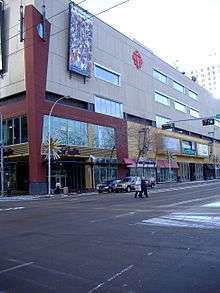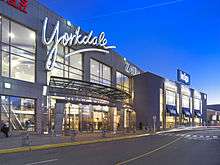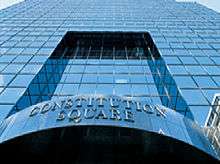Oxford Properties
 | |
| Private | |
| Industry | Real estate |
| Founded | 1960 |
| Headquarters | EY Tower[1], Toronto, Canada |
Area served |
Canada United States United Kingdom |
Key people | Michael Turner (President) |
| Products |
Office Industrial Retail Residential Hotel |
| Services |
Land development Property management Asset management Investment |
| Owner | OMERS |
Number of employees | 2,000+ |
| Website |
www |
Oxford Properties, established in 1960, is a global real estate owner, investor, developer and property manager with a portfolio of office, retail, industrial, multi-residential and hotel assets.[2] Wholly owned by the Ontario Municipal Employees Retirement System since 2003,[3] the company is headquartered in Toronto with regional head offices in New York, London, Singapore and Luxembourg. The organization has 2,200 employees and approximately $50 billion of real assets that it manages for itself and on behalf of its co-owners and investment partners. Oxford’s portfolio of properties represents more than 60 million square feet of office, retail, hotel, industrial, land and multi-residential assets in key global gateway cities. Some of its most recognized assets include Hudson Yards, Yorkdale Shopping Centre, Fairmont Banff Springs Hotel, Olympic Tower and Sony Center. Oxford also owns a portfolio of luxury hotels in Canada as well as rental residential unites in Canada and the US.
Oxford Properties has several significant development projects currently underway in New York City, London, Vancouver and Toronto.
Corporate history
Oxford Leaseholds was established in 1960 in Edmonton by Don Love and John and George Poole, founders of PCL Construction. In the early days of the company’s formation, the partners decided that there was a need for a medical clinic, and they vowed to make it happen. Seven years and a few buildings later, Great-West Life, Confederation Life Insurance Co. and Canada Trust Co. became equity partners.
To reflect its growing desire to develop towers as well as operate them, the company changed its name to Oxford Development Group. The firm entered the 1970s as a publicly traded company, with an offering on the Toronto Stock Exchange, with its assets surpassing $1 billion. At the time, large acquisitions included the Y&R Properties portfolio and 25 shopping centres from Cambridge Leaseholds.
A decade later, a new ownership structure was introduced, as Oxford went private in 1980 in a management-led leveraged buyout. To pay for the deal, it sold its shopping centres. The decade didn't pass quietly however, with assets rising above $3 billion. Oxford Properties set up its headquarters in Toronto's Richmond-Adelaide Centre and sold its U.S. business to BCE Development Corp. Next came a division of companies, as the organization split in two - Oxford Properties Canada Ltd. put the company's real estate back in public hands, and Oxford Development Group stayed private and managed all of the company’s real estate.[4]
Eight years later, the two companies merged and once again went public, with help from a $60 million investment from a Hong Kong investor. The company made significant real estate investments, buying entire portfolios from Marathon, Greiner-Pacaud, Hammerson Canada, Royal Bank and the Canderel Group.
Oxford’s early years
Don Love had arrived in Edmonton in 1955 as an enterprising young stockbroker working for a national securities firm. A physician client approached him about building a medical clinic in Edmonton, asking if he knew of any potential investors. He knew E.E. Poole, another one of his clients, and when Love made the proposal, Ernest Poole declined, but suggested that his sons John and George might have some interest.
The three young men started a new company called “POLO” – "PO" for Poole, and "LO" for Love. Don provided the imagination, while John and George provided the capital. The trio secured a mortgage and built the Baker Clinic, which they then sold back to the doctors of the practice. They were officially in the development business.[5]
Environmental and social responsibility
Oxford Properties ranked first in Sustainability in North America in the Diversified Retail/Office Category by the Global Real Estate Sustainability Benchmark (GRESB) survey for the fourth year in a row in 2016.[6] GRESB is an industry-driven organization committed to assessing the ESG performance of real assets globally, including real estate portfolios and infrastructure assets.[7]
Property gallery
.jpg) Watermark Place, London, UK
Watermark Place, London, UK



 RBC WaterPark Place, Toronto
RBC WaterPark Place, Toronto
See also
Competitors:
References
- ↑ "Contact". Oxford Properties.
- ↑ https://www.newswire.ca/news-releases/oxford-properties-launches-wechat-pay-and-alipay-across-its-canadian-retail-portfolio-making-the-groups-shopping-centres-the-premier-destination-for-chinese-customers-661822173.html
- ↑ http://www.cbc.ca/news/business/omers-to-buy-oxford-properties-for-1-5-billion-1.297344
- ↑ https://www.theglobeandmail.com/report-on-business/oxford-ceo-all-business-regarding-sale-of-familys-real-estate-company/article762945/
- ↑ http://www.torontopubliclibrary.ca/detail.jsp?Entt=RDM2736397&R=2736397
- ↑ https://gresb-public.s3.amazonaws.com/2016/content/2016_NorthAmerica_Snapshot.pdf
- ↑ https://gresb.com/about
- ↑ http://www.oxfordproperties.com/corp/Web/sustainability.aspx
- ↑ http://rbcwaterparkplace.com/